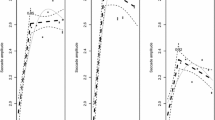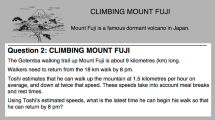Abstract
Although the development of the field of reading has been impressive, there are a number of issues that still require much more attention. One of these concerns the variability of skilled reading within the individual. This paper explores the topic in three ways: (1) it quantifies the extent to which, two factors, the specific reading task (comprehension vs. word verification) and the format of reading material (sentence vs. passage) influence the temporal aspects of reading as expressed in word-viewing durations; (2) it examines whether they also affect visuomotor aspects of eye-movement control; and (3) determine whether they can modulate local lexical processing. The results reveal reading as a dynamic, interactive process involving semi-autonomous modules, with top-down influences clearly evident in the eye-movement record.




Similar content being viewed by others
References
Aaronson, D., & Ferres, S. (1984). Reading strategies for children and adults: some empirical evidence. Journal of Verbal Learning and Verbal Behavior, 23, 89–220.
Aaronson, D., & Ferres, S. (1986). Reading strategies for children and adults: A quantitative model. Psychological Review, 93, 89–112.
Andrews, S., Miller, B., & Rayner, K. (2004). Eye movements and morphological segmentation of compound words: There is a mouse in mousetrap. European Journal of Cognitive Psychology, 16, 285–311.
Ashby, J., Rayner, K., & Clifton, C. (2005). Eye movements of highly skilled and average readers: differential effects of frequency and predictability. Quarterly Journal of Experimental Psychology, 58, 1065–1086
Baayen, R. H., Piepenbrock, R., & van Rijn, H. (1993). The Celex Lexical database. (CD-ROM). Linguistic Data Consortium. University of Pennsylvania, Philadelphia, PA.
Bisanz, G. L., Das, J. P., Varnhagen, C. K., & Henderson, H. R. (1992). Structural components of reading time and recall for sentences in narratives: exploring changes with age and reading ability. Journal of Educational Psychology, 84, 103–114.
Butcher, K. R., & Kintsch, W. (2003). Text comprehension and discourse processing. In F. Healy & R. W. Proctor (Eds.), Handbook of psychology: Experimental psychology (Vol. 4, pp. 575–595). New York: Wiley.
Churchland, P., Ramachandran, V., & Sejnowski, T. (1995). A critique of pure vision. In C. Koch, & J. Davis (Eds.), Large-scale neuronal theories of the brain (pp. 22–60). Cambridge, MA: MIT Press.
Clifton, C., Jr., Staub, A., & Rayner, K. (2007). Eye movements in reading words and sentences. In R. van Gompel (Ed.), Eye movements: A window on mind and brain (pp. 341–372). Amsterdam: Elsevier.
Cook, A. E., & Myers, J. L. (2004). Processing discourse roles in scripted narratives: The influences of context and world knowledge. Journal of Memory and Language, 50, 268–288.
Engbert, R., Nuthmann, A., Richter, E., & Kliegl, R. (2005). SWIFT: A dynamical model of saccade generation during reading. Psychological Review, 112, 777–813.
Garrod, S. C., & Terras, M. (2000). The contribution of lexical and situational knowledge to resolving discourse roles: Bonding and resolution. Journal of Memory and Language, 42, 526–544.
Greenberg, S. N., Inhoff, A. W., & Weger, U. W. (2006). The impact of letter detection on eye movement patterns during reading: Reconsidering lexical analysis in connected text as a function of task. Quarterly Journal of Experimental Psychology, 59, 987–995.
Haberlandt, K., & Graesser, A. C. (1985). Component processes in text comprehension and some of their interactions. Journal of Experimental Psychology: General, 114, 357–374.
Hacker, W., Handrick, S. & Veres, T. (2002). Leseverständnistest (Test of Reading Comprehension). Technical report and test manual. Institute of Psychology. Technical University of Dresden.
Haenggi, D., & Perfetti, C. A. (1994). Processing components of college level reading comprehension. Discourse Processes, 17, 83–104.
Heller, D. (1982). Eye movements in reading. In R. Groner & P. Fraisse (Eds.), Cognition and eye movements (pp. 139–154). Amsterdam: North Holland.
Hendriks, A. (1996). Vergence eye movements during fixations in reading. Acta Psychologica, 92, 131–151.
Hendriks, A. W., & Kolk, H. H. J. (1997). Strategic control in developmental dyslexia. Cognitive Neuropsychology, 14, 321–366.
Hyönä, J. (1995). Do irregular letter combinations attract readers' attention? Evidence from fixation locations in words. Journal of Experimental Psychology: Human Perception and Performance, 21, 68–81.
Hyönä, J., & Olson, R. K. (1995). Eye fixation patterns among dyslexic and normal readers: Effects of word length and word frequency. Journal of Experimental Psychology: Learning, Memory, and Cognition, 21, 1–11.
Inhoff, A. W., & Radach, R. (1998). Definition and computation of oculomotor measures in the study of cognitive processes. In G. Underwood (Ed.), Eye guidance in reading and scene perception (pp. 29–54). Oxford: Elsevier.
Inhoff, A., & Weger, U. (2003). Advancing the methodological middle ground. In J. Hyönä, R. Radach & H. Deubel (Eds.), The mind’s eye: cognitive and applied aspects of eye movement research (pp. 335–344). Oxford: Elsevier.
Jeier, T. (1977). Die Eskimos: Geschichte und Schicksal der Jäger im hohen Norden. (The Eskimos: History and destiny of the hunters in the far north). Düsseldorf: Econ Verlag.
Juhasz, B. J., & Rayner, K. (2003). Investigating the effects of a set of intercorrelated variables on fixation durations in reading. Journal of Experimental Psychology: Learning, Memory, and Cognition, 29, 1312–1318.
Juhasz, B. J., Starr, M. S., Inhoff, A. W., & Placke, L. (2003). The effects of morphology on the processing of compound words. evidence from naming, lexical decisions and eye fixations. British Journal of Psychology, 94, 223–244.
Just, M. A., & Carpenter, P. A. (1980). A theory of reading: From eye fixations to comprehension. Psychological review, 87, 329–354.
Kennedy, A., Radach, R., Heller, D. & Pynte, J. (Eds.) (2000). Reading as a perceptual process. Oxford: Elsevier.
Kliegl, R., Grabner, E., Rolfs, M., & Engbert, R. (2004). Length, frequency and predictability effects of words on eye movements in reading. European Journal of Cognitive Psychology, 16, 262–284.
Kliegl, R., Nuthmann, A., & Engbert, R. (2006). Tracking the mind during reading: the influence of past, present, and future words on fixation durations. Journal of Experimental Psychology: General, 136, 520–529.
Kliegl, R., Olsen, R. K., & Davidson, B. J. (1982). Regression analyses as a tool for studying reading processes. Memory & Cognition, 10, 287–296.
Legge, G. E., Hoven, T. A., Mansfeld, J. S., & Tjan, B. S. (2002). Mr. Chips 2002: new insights from an ideal-observer model of reading. Vision Research, 42, 2219–2234.
McDonald, S. A., Carpenter, R. H., & Shillcock, R. C. (2005). An anatomically constrained, stochastic model of eye movement control in reading. Psychological Review, 112, 814–840.
McConkie, G. W., Kerr, P. W., Reddix, M. D., & Zola, D. (1988). Eye movement control during reading: I. The location of initial eye fixations on words. Vision Research, 28, 1107–1118.
McConkie, G. W., Kerr, P. W., Reddix, M. D., Zola, D., & Jacobs, A. M. (1989). Eye movement control during reading: II. Frequency of refixating a word. Perception and Psychophysics, 46, 245–253.
O’Regan, J. K. (1990). Eye movements and reading. In E. Kowler (Ed.), Reviews of oculomotor research, vol. 4: Eye movements and their role in visual and cognitive processes (pp. 395–453). Amsterdam: Elsevier.
O’Regan, J. K. (1992). Optimal viewing position in words and the strategy-tactics theory of eye movements in reading. In K. Rayner (Ed.), Eye movements and visual cognition: Scene perception and reading (pp. 333–354). New York: Springer.
O’Regan, J. K., & Jacobs, A. M. (1992). Optimal viewing position effects in word recognition: A challenge to current theory. Journal of Experimental Psychology: Human Perception and Performance, 18, 185–197.
O’Regan, J. K., Vitu, F., Radach, R., & Kerr, P. (1994). Effects of local processing and oculomotor factors in eye movement guidance in reading. In J. Ygge & G. Lennerstrand (Eds.), Eye movements in reading. New York: Pergamon.
Pollatsek, A., Hyönä, J., & Bertram, R. (2000). The role of morphological constituents in reading Finnish compound words. Journal of Experimental Psychology: Human Perception and Performance, 26, 820–833.
Pynte, J., & Kennedy, A. (2006). An influence over eye movements in reading exerted from beyond the level of the word: Evidence from reading English and French. Vision Research, 46, 3786–3801.
Radach, R., Heller, D., & Inhoff, A. W. (2004). Does orthographic information modulate saccade amplitudes in reading? European Journal of Cognitive Psychology, 16, 27–51.
Radach, R., & Kennedy, A. (2004). Theoretical perspectives on eye movements in reading: Past controversies, current issues, and an agenda for the future. European Journal of Cognitive Psychology, 16, 3–26.
Radach, R., & McConkie, G. W. (1998). Determinants of fixation positions in reading. In G. Underwood (Ed.), Eye guidance in reading and scene perception (pp. 77–100). Oxford: Elsevier.
Radach, R., Reilly, R., & Inhoff, A. W. (2007). Models of oculomotor control in reading: towards a theoretical foundation of current debates. In R. van Gompel, M. Fischer, W. Murray & R. Hill (Eds.), Eye movements: A window on mind and brain. Oxford: Elsevier.
Rayner, K. (1979). Eye guidance in reading: Fixation locations within words. Perception, 8, 21–30.
Rayner, K. (1998). Eye movements in reading and information processing: 20 years of research. Psychological Bulletin, 124, 372–422.
Rayner, K., Chace, K. H., Slattery, T. J., & Ashby, J. (2006). Eye movements as reflections of comprehension processes in reading. Scientific Studies of Reading, 10, 241–255.
Rayner, K., Pollatsek, A., Drieghe, D., Slattery, T. J., & Reichle, E. D. (2007). Tracking the mind during reading via eye movements: Comments on Kliegl, Nuthmann, and Engbert (2006). Journal of Experimental Psychology: General, 136, 520–529.
Rayner, K., Sereno, S. C., & Raney, G. E. (1996). Eye movement control in reading: A comparison of two types of models. Journal of Experimental Psychology: Human Perception and Performance, 22, 1188–1200.
Reilly, R. G., & Radach, R. (2006). Some empirical tests of an interactive activation model of eye movement control in reading. Journal of Cognitive Systems Research, 7, 34–55.
Reichle, E. D., Rayner, K., & Pollatsek, A. (2003). The E-Z Reader model of eye movement control in reading: comparisons to other models. Behavioral and Brain Sciences, 26, 445–526.
Stanovich, K. E. (1980). Towards an interactive-compensatory model of individual differences in the development of reading fluency. Reading Research Quarterly, 16, 32–71.
Stanovich, K. (2003). Understanding the styles of science in the study of reading. Scientific Studies of Reading, 7, 105–126.
Tinker, M. (1958). Recent studies of eye movements in reading. Psychological Bulletin, 55, 215–231.
Van Gompel, R., Fischer, M., Murray, W., & Hill, R. (Eds.) (2007). Eye movements: A window on mind and brain. Oxford: Elsevier.
Vitu, F., Kapoula, Z., Lancelin, D., & Lavigne, F. (2004). Eye movements in reading isolated words: Evidence for strong biases towards the center of the screen. Vision Research, 44, 321–338.
White, S. J., & Liversedge, S. P. (2006). Linguistic and nonlinguistic influences on the eyes’ landing positions during reading. Quarterly Journal of Experimental Psychology, 59, 760–782.
Williams, R. S., & Morris, R. K. (2004). Eye movements, word familiarity and vocabulary acquisition. European Journal of Cognitive Psychology, 16, 312–339.
Author information
Authors and Affiliations
Corresponding author
Rights and permissions
About this article
Cite this article
Radach, R., Huestegge, L. & Reilly, R. The role of global top-down factors in local eye-movement control in reading. Psychological Research 72, 675–688 (2008). https://doi.org/10.1007/s00426-008-0173-3
Received:
Accepted:
Published:
Issue Date:
DOI: https://doi.org/10.1007/s00426-008-0173-3




